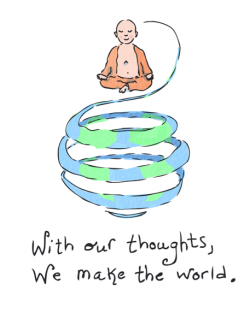“The thought manifests as the word,
The word manifests as the deed,
The deed develops into habit,
And the habit hardens into character.
So watch the thought and its way with care,
And let it spring from love
Born out of concern for all beings.” – the Dhammapada
“With our thoughts we make the world,” goes the old saying. You’ve probably come to yoga because you have decided in one way or another to work on yourself. You may not be so philosophically or spiritually inclined, perhaps the work is to physically tone up, get fit, or fix a bad back. Whatever it may be, we are all looking for something. So setting an intention before you begin the physical work can help focus your awareness on the real purpose, the real fulfilment you’re looking for in stepping onto the mat. Your intention can be a way of connecting your practice to your life.
If you’re anything like me, you could be drawing a blank whenever you hear the words: “Just focus on your heart’s deepest desire/your highest truth/something that resonates deeply with you.” My heart wants a million things; everything resonates with me… and what even is truth?!
Here are 5 simple ways to start forming intentions for your yoga practice. You’ll only need to spend a few long, deep breaths to focus the thoughts in this direction, keeping it as simple as you can and then release the intention – beware of getting too caught up in your own mind-chatter!
1. Gratitude
Even in the darkest of times, we can still find something in our lives that we can be grateful for, if we really set our minds to it. Strangely enough, the more you are in a state of gratitude, the more you will attract things to be grateful for. Start your practice with this vibration of thankfulness and you might find you’re more aware of the joy, freedom or relaxation you feel in certain postures… maybe you’ll even start to get what Jon means when he talks about a forward fold being “delicious”.
2. Forgiveness
Take a few breaths to reflect on something that you’d done that you’d like to be forgiven for, or maybe sending forgiving thoughts to someone who has wronged you. Even if you’re still not feeling able to forgive entirely, I say fake it til you make it – all you need is a tiny shift in energy, and that can make a world of difference. Holding onto bad feelings just doesn’t do us any good, so let go.
3. Guidance
We all feel lost and muddled sometimes – sometimes we just have to admit that we don’t always have the answers. Sometimes we just need help. Reflecting on this can help us to look candidly at any weaknesses we might have, objectively and without judgment or unkindness, and allow ourselves to seek for help in the right places.
4. Dedication
Sending the energy of your practice to someone or something other than yourself can raise your vibrations from an inward, self-centered focus to a more outward-radiating force. As the Buddha says “Thousands of candles can be lit from a single candle, and the light of the single candle itself is never dimmed. Happiness never decreases by being shared.”
5. Universals
I suppose the closest thing to a “highest truth” is something that is commonly shared among us all, that applies to all living beings. Wanting to be free from suffering, the desire for happiness and love. The greeting Namaste means “the light in me bows to the light in you”. When we focus on these universals, we are raising our compassionate energies – we realize that all beings are connected, that we all want the same things. Through cultivating compassion, we become kinder to others, but also to ourselves on and off the mat.
Try these out in your next practice – tell us how you get on! You can find out more about sankalpa (intentions) and the more subtle aspects of yoga practice in Jon Moult’s next workshop, What is Yoga? More info or book HERE.
Photo credit: Molly Hahn
